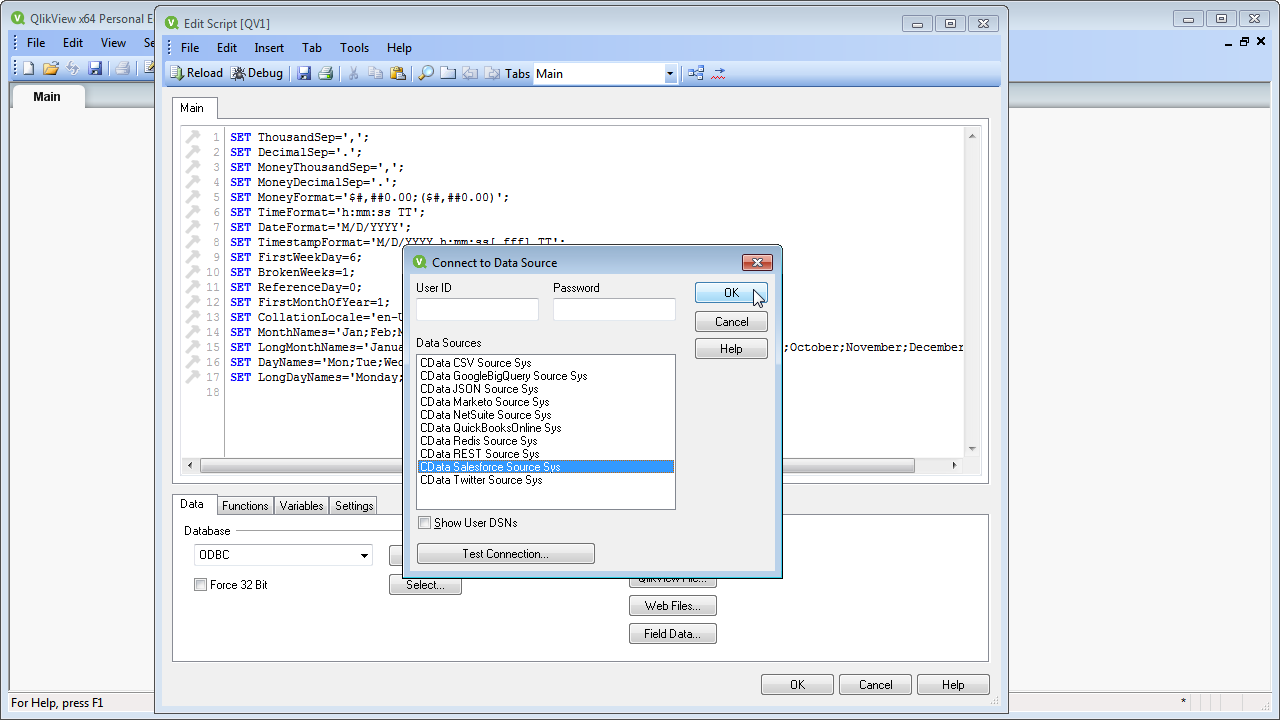Discover how a bimodal integration strategy can address the major data management challenges facing your organization today.
Get the Report →Connect to and Query SAP SuccessFactors Data in QlikView over ODBC
Create data visualizations with SAP SuccessFactors data in QlikView.
The CData ODBC drivers expand your ability to work with data from more than 200 data sources. QlikView is a business discovery platform that provides self-service BI for all business users in an organization. This article outlines simple steps to connect to SAP SuccessFactors data using the CData ODBC driver and create data visualizations in QlikView.
The CData ODBC drivers offer unmatched performance for interacting with live SAP SuccessFactors data in QlikView due to optimized data processing built into the driver. When you issue complex SQL queries from QlikView to SAP SuccessFactors, the driver pushes supported SQL operations, like filters and aggregations, directly to SAP SuccessFactors and utilizes the embedded SQL engine to process unsupported operations (often SQL functions and JOIN operations) client-side. With built-in dynamic metadata querying, you can visualize and analyze SAP SuccessFactors data using native QlikView data types.
Connect to SAP SuccessFactors as an ODBC Data Source
If you have not already, first specify connection properties in an ODBC DSN (data source name). This is the last step of the driver installation. You can use the Microsoft ODBC Data Source Administrator to create and configure ODBC DSNs.
You can authenticate to SAP Success Factors using Basic authentication or OAuth with SAML assertion.
Basic Authentication
You must provide values for the following properties to successfully authenticate to SAP Success Factors. Note that the provider will reuse the session opened by SAP Success Factors using cookies. Which means that your credentials will be used only on the first request to open the session. After that, cookies returned from SAP Success Factors will be used for authentication.
- Url: set this to the URL of the server hosting Success Factors. Some of the servers are listed in the SAP support documentation (external link).
- User: set this to the username of your account.
- Password: set this to the password of your account.
- CompanyId: set this to the unique identifier of your company.
OAuth Authentication
You must provide values for the following properties, which will be used to get the access token.
- Url: set this to the URL of the server hosting Success Factors. Some of the servers are listed in the SAP support documentation (external link).
- User: set this to the username of your account.
- CompanyId: set this to the unique identifier of your company.
- OAuthClientId: set this to the API Key that was generated in API Center.
- OAuthClientSecret: the X.509 private key used to sign SAML assertion. The private key can be found in the certificate you downloaded in Registering your OAuth Client Application.
- InitiateOAuth: set this to GETANDREFRESH.
When you configure the DSN, you may also want to set the Max Rows connection property. This will limit the number of rows returned, which is especially helpful for improving performance when designing reports and visualizations.
Populate a Chart with SAP SuccessFactors Data
The steps below supply the results of an SQL query to a visualization in QlikView. In this article, you will create a bar chart with the query below:
SELECT address1, zipCode FROM ExtAddressInfo WHERE city = 'Springfield'
- Click File -> Edit Script (or click the Edit Script button in the Toolbar).
- On the Data tab, select ODBC in the Database menu and click Connect.
![Connecting to an ODBC data source.]()
- Select the DSN (CData SAPSuccessFactors Sys) in the resulting dialog.
![Selecting a DSN (Salesforce is shown).]() A command like the following is generated:
A command like the following is generated:
ODBC CONNECT TO [CData SAPSuccessFactors Sys]; - Enter the SQL query directly into the script with the SQL command (or click Select to build the query in the SELECT statement wizard).
SQL SELECT address1, zipCode FROM ExtAddressInfo WHERE city = 'Springfield';Where possible, the SQL operations in the query, like filters and aggregations, will be pushed down to SAP SuccessFactors, while any unsupported operations (which can include SQL functions and JOIN operations) will be managed client-side by the CData SQL engine embedded in the driver.
![A script that connects and executes an SQL query. (Salesforce is shown.)]()
- Close the script editor and reload the document to execute the script.
- Click Tools -> Quick Chart Wizard. In the wizard, select the chart type. This example uses a bar chart. When building the chart, you have access to the fields from SAP SuccessFactors, typed appropriately for QlikView, thanks to built-in dynamic metadata querying.
- When defining Dimensions, select address1 in the First Dimension menu.
- When defining Expressions, click the summary function you want and select zipCode in the menu.
Finish the wizard to generate the chart. The CData ODBC Driver for SAP SuccessFactors connects to live SAP SuccessFactors data, so the chart can be refreshed to see real-time changes. Live connections are possible and effective, thanks to the high-performance data processing native to CData ODBC Drivers.
![A chart populated with the results of a query. (Salesforce is shown.)]()







 A command like the following is generated:
A command like the following is generated:


